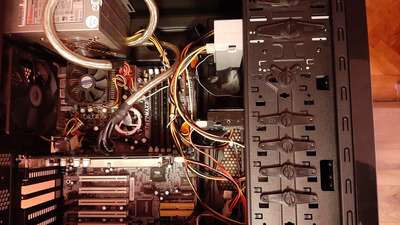Reply 180 of 299, by nd22
The differences are minor, within 5%!
Now it is the turn of the first "real"application: Farcry 1! One of the best game of 2004, highly CPU bound; it is also one of my favorites games. All settings to the MAX, geforce 7800gs is more than capable of handling AA and AF. I used HardwareOC Far cry benchmark tool; the results are displayed in Firefox so no screenshot, just the data!
AT7 with VIA KT333
The benchmark started at 03.05.2023 06:16:36
System Information
Operating system: Microsoft Windows XP
System memory: 2,0 GB
CPU: AMD Athlon(tm) XP 2800+
CPU speed: 2080 MHz
Sound system: : Realtek AC97 Audio
VGA Information
Graphics card: NVIDIA GeForce 7800 GS
Memory: 256.0 MB
Current GPU speed: 375 MHz
Current memory speed: 1200 MHz
Driver version: 6.14.0010.9371 (English)
Resolution: 1024×768
Ultra quality option, Direct3D renderer
Level: Volcano, demo: hocvolcano.tmd
Pixel shader: default model
Antialising: 8×
Anisotropic filtering: 16×
HDR: disabled
Geometry Instancing: disabled
Normal-maps compression: disabled
Score = 54,08 FPS (Run 1)
Score = 52,63 FPS (Run 2)
Score = 52,79 FPS (Run 3)
Average score = 53,16 FPS
Resolution: 1280×1024
Ultra quality option, Direct3D renderer
Level: Volcano, demo: hocvolcano.tmd
Pixel shader: default model
Antialising: 8×
Anisotropic filtering: 16×
HDR: disabled
Geometry Instancing: disabled
Normal-maps compression: disabled
Score = 53,32 FPS (Run 1)
Score = 51,75 FPS (Run 2)
Score = 52,09 FPS (Run 3)
Average score = 52,38 FPS
Resolution: 1600×1200
Ultra quality option, Direct3D renderer
Level: Volcano, demo: hocvolcano.tmd
Pixel shader: default model
Antialising: 8×
Anisotropic filtering: 16×
HDR: disabled
Geometry Instancing: disabled
Normal-maps compression: disabled
Score = 50,90 FPS (Run 1)
Score = 49,82 FPS (Run 2)
Score = 51,01 FPS (Run 3)
Average score = 50,57 FPS









